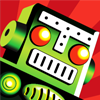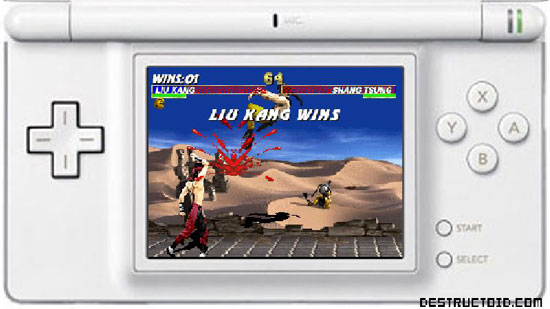If Street Fighter is Monopoly, and Virtua Fighter is chess, then I think it’s safe to say the Mortal Kombat series is the Tic-Tac-Toe. As popular (and controversial) as the series has been, there’s no argument that Midway’s fighter has been one of the least respected of the fighting game franchises.
Sure, when Mortal Kombat went all 3D, it tried to get deeper and all serious on us. But to me, there’s nothing wrong with an entire match of upper cuts and well timed leg sweeps … as long as it’s fun. Think what you will, but as far as I’m concerned, the 2D Mortal Kombat titles have always been a blast. I have fond teenage Super Nintendo memories of the original titles, going head-to-head with my friends into the wee hours of the night, fighting to see who the “real Sub-Zero” was (it was always mine).
So when I heard that Ultimate Mortal Kombat was coming to the Nintendo DS, I was worried. “What kind of awful 3D, touch screen nonsense are they going to shoehorn into the gameplay?” I thought. The answer: Absolutely none, and it’s glorious.
 Ultimate Mortal Kombat DS
Ultimate Mortal Kombat DS
is exactly that: Ultimate Mortal Kombat for the Nintendo DS. If you didn’t like Ultimate Mortal Kombat 3, for whatever the case may be, please move along — there’s nothing to see here. The main game is direct port of the original arcade fighter, and everything is intact, including the sizable roster, arenas, and full arsenal of finishing moves.
The game’s trademark motion captured actors running around in silly costumes look nice on the DS, although the chunky nature of the technology is ever apparent. Still, while the game doesn’t look quite as sharp as the Xbox Live Arcade version of Ultimate Mortal Kombat 3, it’s far from a pixelated mess. Most importantly, the reds pop and are as vivid as ever, and when speaking about a Mortal Kombat title, that’s what’s important … right?
Control wise, I was a bit concerned that the DS Lite’s tiny, cramped controls would be an issue. But all of those fears melted away, when I picked up the unit and starting owning one of the game’s designers, Brian Lebaron. Everything plays exactly like you’d expect, with no bells or whistles — you don’t have to drag a stylus to throw your spear or draw a map of England to pull off your favorite Babality. Like the Super Nintendo version of UMK 3, the face buttons provided attacks, and the left and the right buttons are mapped to run and block. Even the tiny DS D-pad proved to be a non-issue; quarter circle motions were surprisingly easy to pull off.
You might have caught it earlier, but I fessed up to being old. I said I had played a lot of Mortal Kombat when I was a teenager, and I wasn’t lying. I’m a cane and a prostate exam away from a nursing home, so remembering each characters special and finishing moves is way beyond my abilities. So it’s a good thing that the game uses the second screen to display a select number of your characters specials, as well as finishers. It’s a great and helpful feature, one that I’m sure long time fans who can’t remember what they ate for breakfast will appreciate. See — the dual screens are useful for something more than displaying a map!
Included on Ultimate Mortal Kombat is one of my favorite game extras of all-time, MK Puzzle Kombat. Originally included on Mortal Kombat: Deception, Puzzle Kombat was clearly inspired by Capcom’s Super Puzzle Fighter II Turbo, and that certainly isn’t a bad thing. Two-color blocks fall from the top of the screen, and the objective is to match up as many of one color as possible before breaking it with a special gem; the larger the color cluster, the more powerful the attack, which will rain down a hell of random blocks on your opponent.
Unlike Capcom’s puzzler, each character in Puzzle Kombat has his or her own unique special attack which can be triggered with the press of a button once your special meter is filled. These attacks can do things like make your opponent’s blocks invisible, but the end result is always someone cursing you under their breath. Additionally, adorable, super-deformed Mortal Kombat characters will battle it out on the handheld’s second screen. While you’ll like not have a chance to ogle them while you’re mid-game, their adorable nature will surely warm even the coldest of hearts.
Of course, both of the game’s modes can be played using wireless ad-hoc — use two game cards for full-featured multiplayer battles, or take advantage of Game Sharing for battles using a limited character selection. The also takes advantage of the Nintendo Wi-Fi connection, and will allow players to battle it out online in both Ultimate Mortal Kombat 3 and MK Puzzle Kombat. While I didn’t have a chance to hop online, I was assured that it was up and running, and smooth as butter. That is, of course, unless you’re illegally downloading episodes of VH1’s The Pick-Up Artist for educational purposes. If that’s the case, lag is not your biggest problem.
I walked away impressed with UMK, mainly because the game’s developer, Other Ocean Interactive, didn’t try to get fancy with it. The simple, straight forward nature of the title should appeal to fans of the series, who should have nothing to complain about when the game ships this November. Well, they might complain a little bit when I’m kicking their a**es online. Sorry about that.


